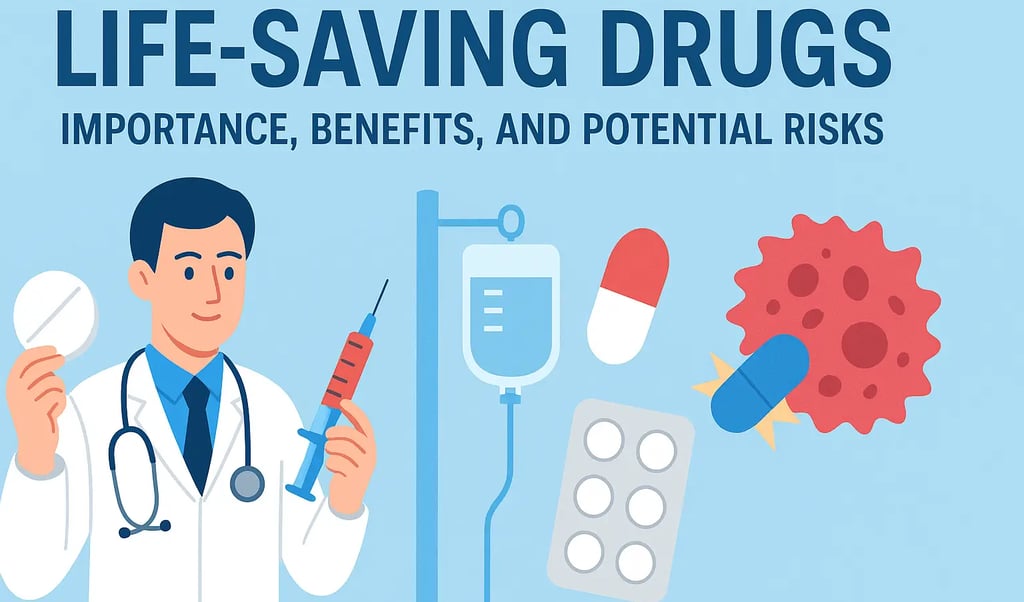Life-Saving Drugs: Importance, Types, Benefits, and Risks Explained
Discover the importance of life-saving drugs in modern medicine. Learn about antibiotics, anticoagulants, chemotherapy agents, their benefits, risks, and impact on healthcare.


Life-Saving Drugs: Importance, Benefits, and Potential Risks
Life-saving drugs are among the most crucial advancements in modern medicine. These medications are designed to prevent death or serious deterioration in patients facing critical health conditions. The importance of life-saving drugs lies in their ability to provide effective treatment during emergencies, improve survival rates, and enhance overall quality of life.
Common categories of life-saving drugs include antibiotics, anticoagulants, and chemotherapy agents, each serving a vital role in healthcare.
Types of Life-Saving Drugs
1. Antibiotics
Antibiotics are life-saving drugs used to fight bacterial infections. Since the discovery of penicillin in the 1940s, antibiotics have drastically reduced mortality rates from once-deadly diseases like pneumonia and sepsis. They remain indispensable in hospitals and outpatient care.
2. Anticoagulants
Anticoagulants, or blood thinners, help prevent life-threatening blood clots such as deep vein thrombosis, pulmonary embolism, and stroke. By improving blood flow, these drugs reduce complications and save lives during critical emergencies.
3. Chemotherapy Agents
Chemotherapy drugs target rapidly dividing cancer cells, slowing or stopping tumor growth. Advances in chemotherapy have significantly reduced cancer-related deaths, transforming certain fatal conditions into treatable diseases.
Characteristics of Life-Saving Drugs
Life-saving drugs are unique because of their critical role in emergency care. Their main characteristics include:
Specific mechanisms of action – e.g., antibiotics target bacteria, while thrombolytics dissolve clots.
High efficacy – proven through clinical trials to lower mortality and improve recovery.
Different dosage forms – tablets, injections, or inhalers to suit patient needs.
Strict regulation – tested extensively by organizations like the FDA to ensure safety and effectiveness.
Benefits of Life-Saving Drugs
The benefits of life-saving drugs extend far beyond emergency care. They have transformed global health by:
Reducing mortality rates from infections, cardiovascular diseases, and cancer.
Extending life expectancy for chronic conditions like HIV/AIDS and diabetes.
Improving quality of life by preventing complications and allowing patients to live normal lives.
Driving medical innovation with more effective and targeted therapies.
According to the World Health Organization (WHO), the introduction of antibiotics, anticoagulants, and advanced cancer drugs has significantly reduced global death rates from major health threats.
Risks and Challenges of Life-Saving Drugs
Despite their benefits, life-saving drugs also come with risks and challenges:
Side effects – ranging from mild discomfort to severe adverse reactions.
Drug interactions – especially in patients taking multiple medications.
Misuse and dependency – particularly with opioids or sedatives.
High costs and accessibility issues – limiting availability for low-income populations.
Healthcare providers must carefully monitor patients to maximize benefits while minimizing risks. At the same time, governments and pharmaceutical companies need to ensure these drugs remain affordable and accessible.
Conclusion
The importance of life-saving drugs in modern medicine cannot be overstated. From antibiotics to chemotherapy, these medications save millions of lives every year, offering hope in the face of life-threatening diseases. While they carry certain risks, their benefits far outweigh the drawbacks. Continued innovation, regulation, and affordability efforts will ensure that life-saving drugs remain a cornerstone of global healthcare.
